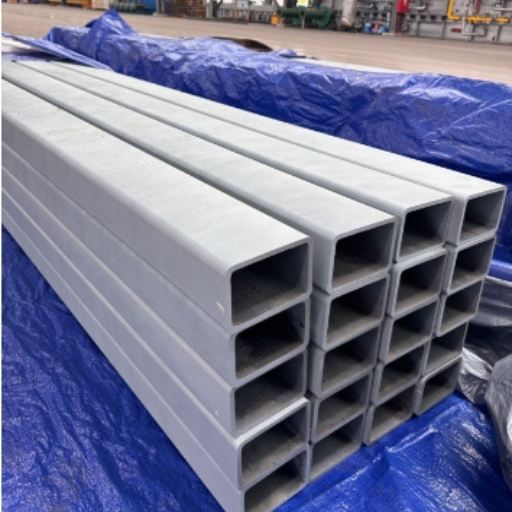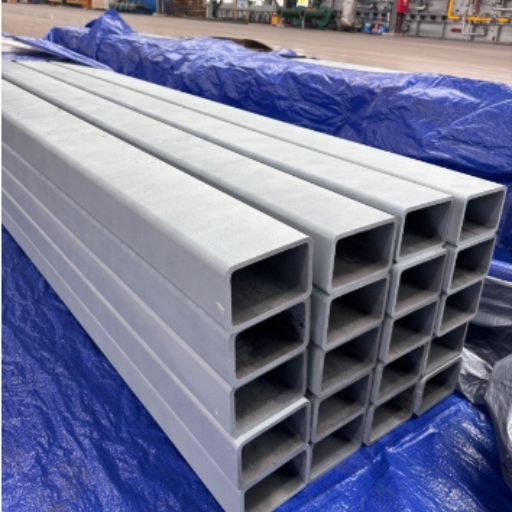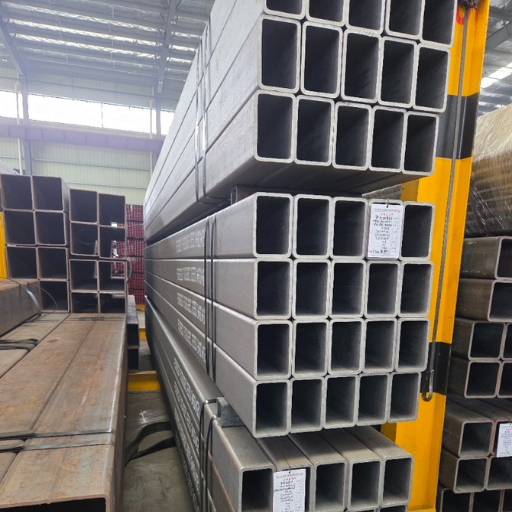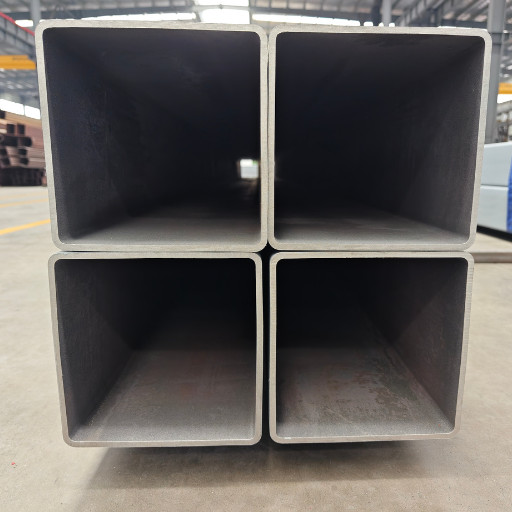-
 Melody
Hi there! Welcome to my shop. Let me know if you have any questions.
Melody
Hi there! Welcome to my shop. Let me know if you have any questions.
Your message has exceeded the limit.

What is Seamless Square Tubing?
2025-10-13 16:49:27
Seamless square tubing is a very flexible and sturdy material that has made its way into many different industries, such as construction, engineering, and even automotive. It doesn't possess the disadvantages usually associated with welded counterparts. The main difference is that seamless square tubing is made with no welded seam at all, resulting in a tube with a smooth and even structure that boosts its strength, reliability, and resistance to stress. This article aims to provide an in-depth discussion on the main features, advantages, and different uses of seamless square tubing so that the readers will really understand why it is the most favored material in demanding projects. If you are seeking to optimize structural integrity or achieve precision in your designs, seamless square tubing will offer the top performance possible. Continue reading to discover its special features and how it can elevate your next project to a new level.
Understanding Seamless Tubing

Seamless tubing is a metal tube that is produced without welding or seams and has a uniform structure throughout its continuous length. With the seamless technique, no weak points are created, meaning the tube can resist pressure or heavy loads and is exceptionally strong and durable. Its precise measurements and smooth interior make it suitable for a wide range of applications such as structural supports, hydraulic systems, and heat exchangers. Seamless tubing is the material of choice in industries where reliability, performance, and structural integrity are of utmost importance.
Definition of Seamless Square Tubing
Seamless square tubing is essentially a hollow metal structure that is square-shaped and produced without welded seams, ensuring consistent strength, accurate sizes, and the ability to withstand very high pressures. This makes it a preferred choice for the application in many areas like construction, the automotive sector, and even industrial machinery.
Comparison: Seamless vs Welded Tubing
Parameter | Seamless Tubing | Welded Tubing |
|---|---|---|
Manufacturing Process | Extruded from solid billet | Rolled and welded from flat strip |
Strength | Stronger, no weak points | Weaker at weld seams |
Corrosion Resistance | Superior due to no seams | Slightly less, welds may corrode |
Pressure Resistance | Higher, ideal for high-pressure applications | 20% lower pressure rating |
Cost | More expensive | More affordable |
Size Availability | Limited size range | Wider size range |
Lead Time | Longer due to the complex process | Shorter, faster production |
Surface Finish | Smoother interior, less contamination risk | Rougher interior may trap debris |
Applications | High-pressure, critical uses (e.g., aerospace) | General-purpose, cost-sensitive uses |
Durability | Highly durable | Less durable in extreme conditions |
Applications of Seamless Tubing
Seamless square tubing has a great variety of applications in the industry because of its excellent mechanical characteristics, precise dimensional control, high stress, and corrosion resistance. Five main applications are described below:
1. Construction and Structural Engineering
Among the main uses of seamless tubing in construction are its applications in load-bearing structures, bridges, and skyscrapers. Its constant strength and longevity make it appropriate for critical uses where safety is the first concern. To illustrate, seamless tubing is often employed in seismic-resistant construction as it can absorb stress without failing.
2. Automotive and Transportation
In the automotive sector, seamless tubing finds application in the manufacture of components like chassis, driveshafts, and suspension systems. Besides, the excellent ratio of strength to weight makes it an effective engineering material along with the compliance with safety standards. For example, seamless steel tubing is often used for the construction of roll cages in racing cars to provide maximum impact resistance.
3. Oil and Gas Industry
The use of seamless tubing continues to be a key factor in the oil and gas industry for applications such as pipelines, drilling rigs, and hydraulic systems. The tubing can withstand the high pressures and extreme temperatures that come along with the processes, thus, making it safe and efficient for the transportation of crude oil and natural gas. Studies have indicated that seamless tubing is responsible for the installation of roughly 70% of the pipelines considered in high-pressure areas.
4. Industrial Machinery and Equipment
Seamless tubing is used in the construction of heavy machinery like cranes, forklifts, and hydraulic drivers. This is because it is very robust and resistant to fatigue. Its ability to withstand cyclic loading over long periods makes it a reliable choice for severe industrial applications that require durability.
5. Aerospace and Defense
The aerospace and defense industries are highly dependent on seamless tubing for the manufacturing of hydraulic lines, fuel systems, and structural reinforcements in aircraft and military vehicles. At the same time, the high-strength weight contributes to better fuel efficiency and reliability in missions that are critical for defense.
These applications highlight the flexibility and crucial importance of seamless square tubing in contemporary industries, where precision, performance, and durability are paramount requirements.
Benefits of Seamless Square Tubing

High Strength-to-Weight Ratio
Seamless square tubing stands out with its extremely high strength-to-weight ratio, making it perfect for industries where structural stability and weight savings are crucial. Apart from that, it has been extensively used in the aviation sector to enhance performance without compromising safety. The feature also contributes to the increased energy efficiency in the transport sector.
Enhanced Corrosion Resistance
Seamless square tubing made from stainless steel or specialty alloys offers such excellent metallic corrosion resistance that it acts like a protective shield against oxidation in harsh environments. Hence, it's the most favored material for marine, oil, and gas, and chemical processing industries, where the apprehension of corrosion is a normal phenomenon.
Superior Dimensional Precision
The seamless tubing is produced to very strict tolerances, ensuring that dimensions and uniformity are consistent throughout. Such precision is necessary for those applications where close fits and smooth mechanical integration (e.g. hydraulic and structural assemblies) are required.
Improved Load-Bearing Capacity
The seamless construction process produces no weak points, such as welding seams, which would otherwise become locations with a high chance of failure under stress. The structural benefits derived from that enable the even flow of load forces, thus making seamless tubing a good choice for the most demanding load-bearing applications in construction and heavy machinery.
Versatility in Material Grades and Sizes
Seamless square tubing comes in a variety of material grades, such as carbon steel, stainless steel, and alloy steel, plus many different sizes to suit each particular application, thus making it very versatile. That gives it the ability to satisfy the varied needs of the construction, automotive, and aerospace industries.
Advantages Over Welded Tubing
Enhanced Structural Integrity
Seamless square tubing is made without any welded joints, which significantly reduces the likelihood of weak points that can affect the performance of the structure. Thus, it is more dependable under high-pressure and high-stress situations than welded tubing.
Superior Durability and Corrosion Resistance
Seamless tubing shows higher resistance to environmental factors like corrosion and fatigue, generally because of the lack of welds. It is excellent for applications in harsh environments or where corrosive substances are present.
Higher Pressure and Load-Bearing Capabilities
The consistent construction of seamless tubing gives it an improved capability to resist internal pressure and heavy loads. Industry data claim that seamless tubes can take pressures that are 20% more than equivalent welded tubes of the same grade and size.
Improved Accuracy and Finish
Seamless tubing is produced using tighter tolerances and smoother surface finishes, which allows it to perform better in precision-critical applications, like hydraulic systems and aerospace components. The excellent surface quality also lessens the likelihood of stress concentrations.
Resistance to Deformation and Stress Cracking
Thanks to its uniform composition and absence of weld zones, seamless square tubing provides higher resistance to deformation under heavy loads and eliminates the concern of stress cracking at the seams. This makes it a reliable choice for rigorous industrial applications.
Strength and Durability
Seamless square tubing has the strength and durability that are even more than necessary for high-performance applications in different industries. It has superior axial and torsional strength due to its uniform structure, free of the inconsistencies of welded seams. Research has confirmed that the seamless tubing can handle pressures much higher than those of the welded types. To be specific, the data reveals that seamless tubing has a pressure rating about 20% to 30% higher than the welded one with the same size and thickness, making it an absolute necessity in fluid conveying applications under extreme conditions.
Besides, the seamless square tubing can endure fatigue of very high magnitude without losing its original properties. The modern manufacturing processes, such as high-precision cold drawing and heat treatment, really contribute to the high quality of the finished product. For example, the tensile strength of seamless square tubing can reach up to 60,000 PSI and even more, depending on the alloy and specific processing techniques applied. This guarantees its performance in heavy-duty applications like construction frameworks, automotive chassis, and energy infrastructure.
In addition, there are no weld seams that can eventually rip apart the material, because the strength and durability of the material are greatly improved by their elimination. The research has indicated that the welded seams are likely to lead to the formation of micro-cracks that will eventually grow under stress, but this is a risk that does not exist in seamless tubing. The combination of these characteristics qualifies seamless square tubing as the most suitable material for safety-critical and load-bearing structural applications.
Resistance to Corrosive Environments
Seamless square tubing is an exceptional material in the marine, chemical, and petroleum industries due to its corrosion resistance. The resistance mainly comes from the uniform metallurgical structure that is formed during the manufacturing process and the use of high-performance alloys such as stainless steel, duplex steel, and nickel-based materials.
Research has indicated that seamless stainless steel tubing, especially the grades like 316L and super duplex (2507), are tolerable to the environments containing chlorides and other harsh chemicals. For example, 316L seamless tubing has higher molybdenum content (typically 2-3%), which allows the tubing to resist pitting and crevice corrosion in saltwater environments. At the same time, duplex stainless steel tubing offers the best strength-to-corrosion-resistance ratio, with a PREN (Pitting Resistance Equivalent Number) over 35, making it suitable for offshore oil rigs and desalination plants.
Moreover, using seamless tubing with protective coatings or passivation treatments is a further development that reduces surface reactivity, thereby prolonging the life of the tubing. A recent technical report states that the materials’ lifetimes could be increased by as much as 40% due to these coatings even under acid or oxidizing conditions. In the end, seamless square tubing is a material that combines mechanical integrity with corrosion resistance, making it a perfect choice for critical applications exposed to harsh environmental factors.
Manufacturing Process of Seamless Tubing

The seamless tubing manufacturing process involves meticulously controlled techniques that eliminate welding, resulting in a solid structure with consistent strength and improved performance. The first step is usually to take a solid metal billet, commonly made of carbon steel, stainless steel, or other alloys, and heat it to the required temperature for forging. Recent manufacturing knowledge suggests that the forging temperature usually lies between 1,200 and 1,300; however, it can be altered depending on the type of material being processed.
The moment the billet is heated up to the required level, it gets pierced with the help of a rotary piercing mill or through a perforation process. The result is a hollow shell, even though the material’s strength is intact, which is one of the main factors determining how well the part will perform in high-pressure or high-temperature situations. By using rotary piercing mills, the inner part of the tube gets the same diameter all through for it applies forces in such a way that all pressure goes into making the tube's wall uniformly thinner.
Post-piercing, the hollow shell goes for elongation milling, where its walls are further thinned and the diameter is adjusted to specific requirements. The plug mill or mandrel mill is one of the advanced rolling technologies used at this stage to improve precision further. Nowadays, the elongation practices ensure that the wall thickness tolerances are as low as ±12.5% and the outer diameter tolerances are within ±5%.
Reheating, sizing and heat treatment processes are subsequent steps that refine the mechanical properties like tensile strength and hardness while residual stresses are being reduced. Detection of any defects internally or at the surface is made through non-destructive testing, such as ultrasonic and eddy current tests, ensuring that only quality products meeting the strictest market standards are retained. According to the international standards, ASTM A213 and A519, seamless tubing with tensile strengths exceeding 75,000 psi is achieved through the right alloy composition and heat treatment process.
With the blend of precision engineering, high-quality materials, and rigorous testing, the seamless tubing comes to serve as a major part in many industries such as oil & gas, aerospace, automotive, and construction, where dependability and performance are of prime importance.
Raw Materials Used
Seamless tubing production mainly depends on top-quality raw materials, which are usually steel or alloys of grades that meet stringent specifications regarding their durability and performance. The whole process starts with the use of high-grade carbon steel, stainless steel, or even specialty alloy steels such as chromium-molybdenum (Cr-Mo) or nickel. The materials are selected for their ability to withstand extreme conditions of heat, pressure, and even corrosive environments. For instance, ASTM A106 for carbon steel and ASTM A312 for stainless steel are grades that are commonly used due to their excellent mechanical properties and resistance to simply degrading by the environment.
The current state of the industry indicates that the global demand for alloy and stainless steel materials suitable for seamless tube production has been increasing. A CAGR of over 5% for high-performance alloys like nickel or titanium alloys is projected through 2028. Furthermore, material purification processes, such as vacuum degassing and electro-slag remelting, have enabled the guarantee of a very low level of impurities in raw materials, thereby increasing the mechanical stability of the finished tubing.
The quality of these raw materials is constantly monitored, typically involving ultrasonic testing and spectrochemical analysis, and complies with standards like ISO 9001 and ASME. Such robust control measures imply that the foundation materials can meet the operational requirements of critical industries. These include oil and gas, where the tubing must accommodate ultra-high pressure and corrosive substances, and aerospace, which demands lightweight yet highly durable materials.
Steps in the Manufacturing Process
Material Selection and Inspection The entire process of manufacturing initiates with the choosing of the finest raw materials. That selection of materials includes types of metal like stainless steel, carbon steel, and special alloys which are conformed or adjusted to the desired application. A huge batch of raw materials undergoes an extensive inspection, including chemical composition analysis and ultrasonic testing, to detect any internal flaws or inconsistencies. Automated spectrochemical analysis systems, which are being integrated by more than 90% according to the latest industry data, are a big contributor to the improved efficiency and accuracy of this phase of the manufacturing process.
Forming or Shaping the Material The line of action proceeds with the sculpting of the raw material into the targeted shape. In the case of tubing or pipe, the most popular methods of formation are extrusion, rolling, and cold drawing. The operation of advanced extrusion machines, which work at more than 30,000 psi, allows the production of seamless tubes with better strength and consistency. Another method that is very much liked in the aerospace industry, due to precision tolerances as fine as ±0.05 mm, is cold drawing.
Heat Treatment Once the metal is shaped, it is subjected to controlled heating processes like annealing, normalizing, or quenching and tempering in order to achieve the desired mechanical properties. With the help of modern induction furnaces, heating uniformity is achieved, and energy consumption is up to 25% lower than that of the traditional methods. It has been found that this one step can increase the tensile strength and ductility of the material by up to 40%, depending on the chemical composition.
Surface Treatment The surface treatment process improves the properties of the underlying material against corrosion and is also considered an aesthetic factor. Specific processes, such as pickling, passivation, and electroplating, are carried out in clean and perfectly controlled conditions to eliminate impurities and extend the life of the material. One of the most common procedures with stainless steel tubing is pickling and passivation, where baths of nitric or citric acid, or both, are used to remove surface contaminants, thus meeting the requirements of ASTM A380 standards.
Precision Machining: A cutting-edge computer numerical control (CNC) machining tool is used to produce the pieces according to their exact specifications. The type of machinery that can achieve tolerances as narrow as ±0.01 mm is becoming increasingly prevalent in the medical and electronics sectors, where speed and precision are crucial. According to market research, the CNC automation process is responsible for about a 35% reduction in machine time compared to traditional methods.
Non-Destructive Testing (NDT) The final product undergoes non-destructive testing techniques, such as radiographic or hydrostatic pressure testing, to confirm its integrity and performance under stress before receiving final approval. For their part, hydrostatic tests on high-pressure pipes are the norm. These tests are usually performed at 1.5 times the maximum operating pressure to expose the piping to simulated extreme conditions and, at the same time, discover any weak spots.
Final Documentation and Quality Assurance. After the product has passed all tests, it is labeled, marked, and packaged for shipment. Along with the product, detailed documentation covering material certifications, test reports, and traceability records is also provided, ensuring compliance with industry standards such as ASME, API, or DIN. The use of comprehensive digital tracking systems is increasing, enabling manufacturers to have complete responsibility and facilitate the reporting of audits.
The structured process guarantees that the final product is not only compliant with regulations but also reliable in operation, reflecting technological advancements and manufacturing precision.
Quality Control and Tolerance Levels
Quality regulation in production is of utmost importance for components and systems to meet the previously set standards of accuracy, durability, and performance. Strictly accurate tolerances determine the process to a great extent, as they specify the maximum allowed deviation from the dimensions or performances. Here are five essential aspects of quality control and their tolerance levels listed:
Dimensional accuracy
Tolerance level: ±0.001 inches (±0.0254 mm) for exact components.
Description: Guarantees that all parts produced are measured exactly and that in such industries as aerospace and medical devices, articles unfit for them are minimized, and that the manufacturers save on production costs.
Material hardness
Tolerance range: ±2 HRC (Rockwell Hardness Scale).
Description: The day-to-day verification means that the sharpest materials will be the strongest ones and that their life cycle will be kept polite under stress because of the non-durable materials.
Surface roughness
Tolerance level: Ra 0.8 µm (average roughness).
Description: The smoothness of the time-consuming process with the aid of compensating surface roughness, which in turn saves wear and tear, thereby making maintenance easier and faster.
Weight deviation
Tolerance range: ±1% of specified weight.
Description: This regulation guarantees that no one can tell if products are to be interchanged together, like in the automotive and structural applications, since in some cases, weight may impact the functionality or even stability of the operation.
Alignment and flatness
Tolerance level: ±0.003 inches per linear foot.
Description: The more perfect it is in terms of dimensions, the more they can hold together and the less risk they will be to the whole structure, which does precisely all that could be for parts needing precision alignment to be assembled.
Regular checkups and orderly testing with advanced metrology tools, such as coordinate measuring machines (CMM) and optical profilers, are crucial for achieving the required tolerances. This rigorous procedure not only reduces variations but also ensures the product's top quality and compliance with stringent industry regulations.
Tags: What is seamless square tubing?


